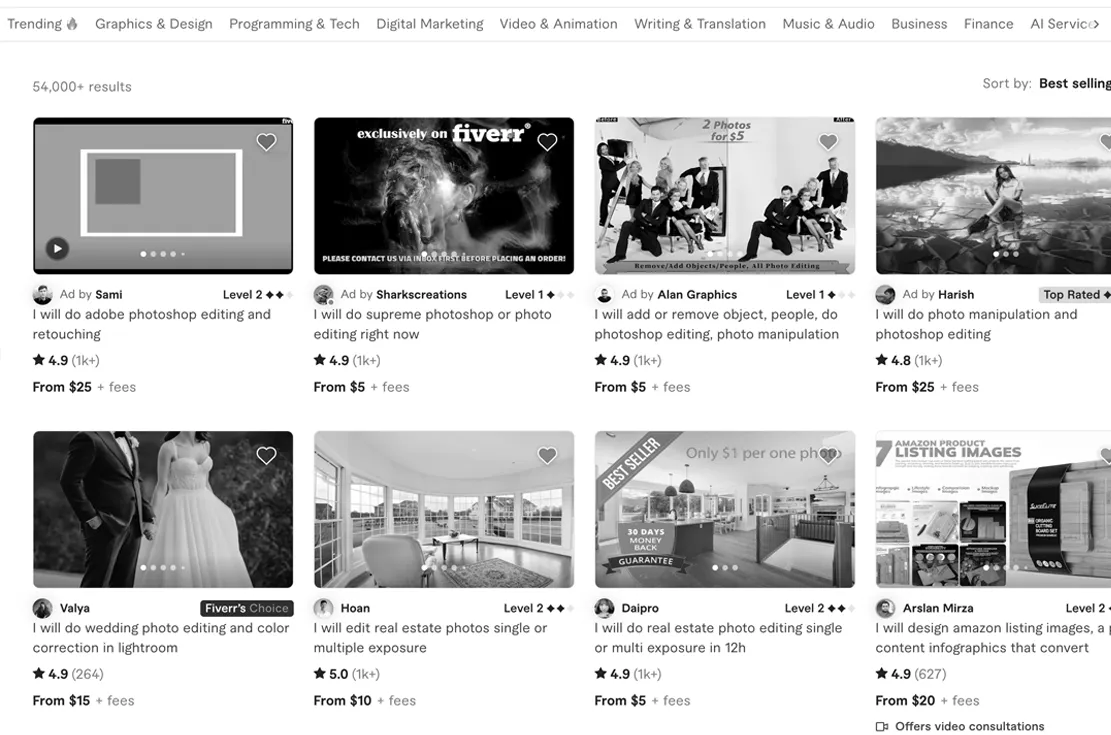Photo Retouching Services: The Complete Guide (2025 Edition)

Photo retouching has come a long way from manual dodge-and-burn techniques in the darkroom. Today, photographers, marketers, and everyday users have access to an entire spectrum of retouching options—from fast mobile apps to fully outsourced services handled by expert editors.
This guide provides an objective overview of the most common retouching approaches, their tradeoffs, and a comprehensive comparison of service providers across categories.
What Is Photo Retouching?
Photo retouching is the professional process of refining an image to improve its visual impact, correct flaws, and align it with a specific creative or commercial goal. It goes beyond simple tweaks, blending precise technical work with a trained eye for detail so the image feels authentic, balanced, and visually refined.
Typical retouching work may involve:
- Blemish removal & skin smoothing – Eliminating acne, scars, or uneven skin texture while preserving natural pores and fine detail.
- Color correction & tonal balancing – Adjusting white balance, shadows, and highlights to achieve accurate or stylized color representation.
- Teeth whitening & eye enhancement – Subtly brightening key facial features without creating an artificial look.
- Background cleanup – Removing distractions, correcting perspective issues, and blending the subject seamlessly with its surroundings.
- Object or element removal – Erasing unwanted items such as wires, stains, or photobombers while maintaining texture consistency.
Retouching workflows can range from quick, automated edits using AI-based tools for social media content, to meticulous, multi-layer edits in professional software for high-end commercial, print, or publication use. The complexity can vary widely — a high-resolution image destined for a magazine cover demands far more precision than a small web thumbnail, and the intended use often dictates how exact the details must be.
Popular Approach: DIY Retouching Tools
DIY retouching tools are ideal when you want quick results without bringing in a professional. They combine AI-driven shortcuts — such as skin smoothing, sky replacement, or background cleanup — with traditional manual controls like exposure, color balance, and curves. They’re best suited for situations where speed and cost take priority over pixel-perfect precision or strict creative direction.
What Matters Most When Choosing a DIY Tool
- RAW workflow: If you shoot RAW, pick a tool that opens RAW natively and edits non‑destructively.
- Layers & masking: Needed for believable composites, targeted fixes, and “edit without damage.”
- Batch & presets: Essential for event sets or ecommerce catalogs to keep a consistent look.
- Local (offline) vs. web: Local apps handle large files faster and keep images private. Web apps win for convenience and templates.
Popular DIY Retouching Tools
- PhotoMator : Photo editor for Mac, iPhone, and iPad, with basic editing tools and filters.
- Luminar Neo : Desktop software with AI skin enhancer, portrait relighting, background replacement—popular among photographers seeking Lightroom alternatives.
- Pixlr : Online picture editor with less functions than PhotoPea but with a modern interface. Supports layers, filters, and more.
- Fotor : Online picture editor similar to Pixlr with some functions from Canva. More graphic design tools and less picture editing tools.
- Adobe Photoshop Express : Mobile version of Photoshop with simplified tools for basic retouching, blemish fixes, filters, and background blur—designed for quick on-the-go edits.
- Remini : AI-powered photo retouching app with advanced tools for skin smoothing, blemish removal, and color enhancement. Ideal for low-resolution casual photos and quick on-the-go edits.
- Aftershoot : AI-powered photo culling and retouching for photographers, with pre-built AI style templates.

When a DIY Tool Is the Right Choice
- Small, well‑defined changes: Blemish cleanup, exposure/white balance, light skin smoothing.
- Deadline is “now”: Social publish, marketplace listing, event recap where perfect is not required.
- Budget constraints: You need decent results without ongoing service fees.
Decision Cheatsheet
- Need RAW + batch + local privacy: Photomator or Luminar Neo.
- Browser‑based convenience + templates: Pixlr or Fotor.
- Quick retouching before social posting: Remini.
A Step Up: Done-for-You Retouching Services
With a done-for-you retouching service, the editing isn’t your job at all — you send the files, explain what you want, and get back finished images ready to use. There’s no need to learn software, click through menus, or coordinate with multiple freelancers. A dedicated team handles every step, applying the right techniques for each image so the results are consistent, on-brand, and delivered within an agreed timeframe.
This option works well for photographers with regular shoots, e-commerce sellers with large product catalogs, and any business that values dependable turnaround and professional polish.
How it differs from DIY tools
- Human judgment where it matters. Experienced editors read the subtleties in light, skin texture, edges, and overall realism — the kinds of calls a preset or filter can’t reliably make.
- Built‑in quality checks. Images pass through review and refinement steps to make sure they match your brief before delivery.
- Capacity without compromise. Teams can move hundreds of files through a pipeline in parallel while keeping style and turnaround consistent.
- Your time back. You’re not opening software or nudging sliders; finished files arrive ready for web, print, or handoff to clients.
- Specialized work beyond apps. Clean object removals, believable composites, perspective fixes, and other advanced tasks that require both technical skill and a creative eye.

This model works best when your priority is accuracy and polish over experimentation — such as e-commerce catalogs, wedding albums, real estate listings, or marketing campaigns where every image must meet brand standards.
We’ve rounded up some of the most popular Done-for-You Retouching Services: Digi5 Studios , Picsera , Vital Edit , Tucia , Retouche , Pixelz , Retouch.ca , FixThePhoto , WeEdit.photos , PhotoRelive , and compiled them into a single view.
Below, you’ll find a comprehensive side-by-side table comparing their core features, from pricing and turnaround time to file format support and revision/refund policies.
|
Retouch.ca
|
Tucia
|
Picsera
|
Retouche
|
VitalEdit
|
Pixelz
|
Digi5
|
FixThePhoto
|
WeEdit.photos
|
PhotoRelive
|
|
|---|---|---|---|---|---|---|---|---|---|---|
| Company Base |
🇨🇦 Canada
|
🇨🇦 Canada
|
🇺🇸 USA
|
🇺🇸 USA
|
🇺🇸 USA
|
🇩🇰 Denmark
|
🇮🇳 India
|
🌐 Not shown
|
🌐 Not shown
|
🌐 Not shown
|
| Typical Price |
⚠️ Custom quote only
|
From US$8
|
⚠️ Custom quote only
|
US$12–15
|
US$45/hour
|
US$95–1,995/month
|
From US$0.75
|
From US$6
|
From US$6
|
US$2.5–4
|
| Turnaround Time |
⚠️ Not shown
|
Typically 24h
|
⚠️ Not shown
|
Typically 24h
|
Typically 24h
|
Varies
|
⚠️ Not shown
|
Standard 48h
|
Typically 48h
|
24h for 100 photos
|
| RAW File Upload |
⚠️ Not shown
|
✅ Supported
|
⚠️ Not shown
|
⚠️ Not shown
|
⚠️ Not shown
|
✅ Supported
|
⚠️ Not shown
|
✅ Supported
|
⚠️ Not shown
|
⚠️ Not shown
|
| HEIC File Upload |
⚠️ Not shown
|
✅ Supported
|
⚠️ Not shown
|
⚠️ Not shown
|
⚠️ Not shown
|
✅ Supported
|
⚠️ Not shown
|
✅ Supported
|
⚠️ Not shown
|
⚠️ Not shown
|
| Free Revisions |
⚠️ Not shown
|
✅ Yes
|
✅ Yes
|
✅ Yes
|
✅ Yes
|
⚠️ Not shown
|
⚠️ Not shown
|
✅ Yes
|
✅ Yes
|
✅ Yes
|
| Money-back Guarantee |
⚠️ Not shown
|
✅ Yes
|
⚠️ Not shown
|
✅ Yes
|
⚠️ Not shown
|
⚠️ Not shown
|
⚠️ Not shown
|
⚠️ Not shown
|
⚠️ Not shown
|
⚠️ Not shown
|
A Middle Ground: Freelance Marketplaces
Sitting between DIY editing apps and full-service retouching companies are freelance marketplaces, where you contract directly with an individual retoucher. These platforms act as intermediaries — handling payment processing and basic dispute resolution — but the quality, pricing, and workflow are determined by the seller you choose.

Popular Platforms:
- Fiverr ( fiverr.com ) – Gig-based listings with fixed-price packages. Many start below US$10 , though experienced retouchers charge more.
- Upwork ( upwork.com ) – Project-based hiring with hourly or fixed contracts.
- Freelancer ( freelancer.com ) – Bidding-style marketplace where you post a job and receive proposals.
Advantages: Significantly lower entry cost than most studios; flexible scope (from one-off blemish removal to large catalog projects); choice of specialists for niche needs such as jewelry, restoration, or creative composites. Many sellers offer free revisions , and refunds are available through platform policies if results are unsatisfactory.
Limitations: Quality control varies widely; portfolios and reviews may not always reflect current skill level. Turnaround times range from a few hours to several days depending on workload and time zone. No guaranteed money-back policy beyond the platform’s dispute resolution. Requires more buyer involvement — writing a clear brief, sharing reference images, and providing timely feedback — compared to full-service providers.
Best fit: Buyers who have clear specifications, are willing to vet candidates, and want a balance between cost savings and customization without committing to a long-term studio contract.
Choosing the Right Option for Your Needs
The right retouching solution depends on four main factors: budget, turnaround time, quality expectations, and the level of collaboration you want with the editor. Using the data from our competitor analysis, you can narrow down the best fit for your workflow.
Tip: If your work is time-sensitive, prioritize vendors with proven 24-hour delivery. For creative or high-value images, focus on providers with clear revision and refund terms. If budget is the main driver, filter by providers listing rates under US$5 per image.
|
Scenario
|
Best Option
|
|---|---|
|
Fast delivery for individuals
|
|
|
Budget is top concern
|
|
|
For high-end, complex retouching
|
|
|
Bulk Ecommerce Photo Retouching
|
|
|
Strong buyer protection
|

Final Thoughts
Over the past few years, retouching has quietly shifted from being a purely manual craft to something shaped by both software and human judgment. AI is now strong enough to handle certain isolated adjustments — fixing colors across a batch of shots, cleaning up small distractions, or giving skin a quick polish — and it can do these in seconds.
But a good retouch is rarely about just one fix. It’s about how light, texture, and composition all work together so the image feels deliberate and complete. That kind of cohesion still depends on the human eye — not just for technical precision, but for reading the mood of a scene and deciding what should be emphasized or left alone.
It’s likely that AI will keep closing the gap in the next few years, even producing results that, for some uses, will be hard to tell apart from professional work. Yet in high-stakes settings — a brand campaign, a print magazine, a luxury product shoot — human-led direction will remain the safeguard against subtle mistakes that algorithms might miss.
For most people, the future will be a mix: letting AI do the heavy lifting on repetitive edits, while human editors shape the tone, make the judgment calls, and ensure the work fits the purpose. The best services today are already leaning into that model, and choosing one now is as much about meeting your current needs as it is about being ready for that hybrid way of working.







